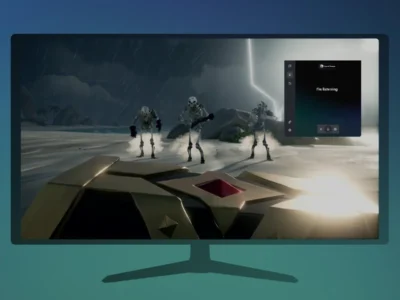Key Points
- Intel confirms Arc GPUs will continue alongside Nvidia graphics
- Nvidia GPU chiplets to be integrated into future Intel CPUs
- Intel insists the partnership is “complementary,” not a replacement
- Analysts question Intel’s long-term commitment to GPUs
In a surprising yet strategic move, Intel has confirmed that Intel Arc GPUs will continue to be part of its product lineup, even after partnering with Nvidia to include Nvidia GPU chiplets in its future CPUs.
This major update comes directly from Nvidia CEO Jensen Huang, who recently revealed that Intel will begin using Nvidia’s GPU chiplets in its x86 processors.
These chiplets will replace Intel’s current integrated graphics in some future products, sparking questions about whether Intel is backing away from its Arc GPU ambitions.
But Intel isn’t giving up just yet.
“We’re not discussing specific roadmaps at this time,” Intel told PCWorld, “but the collaboration is complementary to Intel’s roadmap, and Intel will continue to have GPU product offerings.”
Remember the nForce days.
With Intel keeping Intel GPUs (tiled or discrete) as option, Intel can negotiate and cuck over NVIDIA still. Though NVLINK C2C will unlikely get NVIDIA into trouble.For NVIDIA it’s their new trojan-horse. Another attempt into mobile SoC ecosystem. pic.twitter.com/IkhTSiKrm2
— Bullsh1t_Buster (@Bullsh1t_buster) September 19, 2025
This message reflects the same tone as earlier statements by Michelle Johnston Holthaus, Intel’s former EVP, before her sudden departure from the company.
While leadership changes often signal a shift in direction, Intel’s latest response seems to aim at reassuring both investors and consumers that Intel Arc GPUs are here to stay, at least for now.
Interestingly, this kind of strategic collaboration mirrors what we’ve seen with OpenAI’s massive Oracle Cloud deal, where partnerships are becoming the key to scalability and speed in tech innovation.
Win–win for NVIDIA & Intel.
Intel opens a corridor for NVIDIA into the 70% iGPU market; NVIDIA shares server sockets with Intel.
Intel Foundry is the bigger winner — more wafers to fill fabs.
Lip-Bu solves the conflict: co-design with customers, manufacture for them.Great move. pic.twitter.com/aeOfwRCsIk
— Intel Pro Max Ultra (@PetGelsinger) September 18, 2025
Will Intel Stay in the GPU Game for Long?
Despite the firm’s current stance, industry analysts remain skeptical about how far Intel is willing to go with its GPU ambitions.
So far, Intel Arc GPUs like the A750 have shown competitive performance against Nvidia’s mid-range cards like the RTX 3060. That’s a respectable start, especially for a newcomer trying to break into a GPU market long dominated by Nvidia and AMD.
In fact, the Intel Arc GPU lineup has already powered some successful launches, from budget-friendly desktop builds to mobile platforms like MSI’s Claw handheld, which surprised many with its smooth performance using Intel graphics.
intel Integrated GPU and Desktop GPU and Jaguar Shores AI GPU roadmap no change , of course Nvidia ARM CPU roadmap also no change , people speculate too much it pic.twitter.com/FI9xDUpbv5
— meng (@meng59739449) September 18, 2025
But there’s no denying the financial and technical challenge of competing with Nvidia, especially now that they’re partners. Intel has already offloaded several business segments to reduce operational costs.
With Nvidia now supplying GPU chiplets directly, some believe Intel may quietly dial back its internal GPU efforts over time.
Still, the word “complementary” leaves some room for hope. It suggests that Intel Arc GPUs may continue to target specific markets, such as budget desktops, entry-level gaming, or integrated solutions for laptops, areas where price-to-performance ratios matter more than raw power.
This echoes how companies like Grammarly are adding multilingual AI capabilities, not by replacing their core, but by expanding intelligently into new demand areas.
What the Nvidia Deal Really Means for Intel Arc GPUs
The partnership between Intel and Nvidia is clearly a tactical move. By adopting Nvidia’s advanced GPU chiplets, Intel can build CPUs that immediately benefit from years of GPU innovation, without having to play catch-up with its own architecture.
But that doesn’t necessarily mean Intel Arc GPUs are obsolete. Instead, Intel could pivot and reposition Arc products for more focused use cases, especially where high-end Nvidia chips are overkill or too expensive.
For example, educational devices, business laptops, or casual gaming systems could continue using Intel Arc GPUs for efficient, cost-effective performance. Meanwhile, more premium systems could leverage Nvidia’s GPU chiplets for high-end gaming and content creation.
This two-track strategy may allow Intel to maintain a footprint in the GPU market while simultaneously benefiting from Nvidia’s graphics leadership. It also offers Intel the flexibility to grow Arc without having to compete directly with Nvidia at every level.
That said, the biggest challenge will be perception. If Intel doesn’t actively promote and improve Intel Arc GPUs, consumers and developers might lose interest, and the brand could fade, regardless of its potential.
This scenario would be similar to how Google’s Veo and Photos integration is reshaping how AI interacts with creative tools, evolving but not replacing the core offering.
What This Means for the Future of PC Graphics
The move also highlights a broader shift in the way CPUs and GPUs are being developed.
By using chiplets, smaller, modular silicon components, companies like Intel can mix and match technologies from different vendors. This modularity gives manufacturers more flexibility, lowers production costs, and can speed up time-to-market.
In this new model, Intel Arc GPUs could still play an important role, not as Nvidia’s competitor, but as part of a diverse ecosystem of graphics solutions. Intel may focus its Arc line on specific market needs, such as AI, edge computing, or integrated graphics for power-efficient devices.
As the PC industry evolves, we might not see a one-size-fits-all approach to graphics anymore. Instead, we’ll see a mix of options, from high-end Nvidia chiplets to lightweight Intel Arc GPUs, all working within a broader architecture.
For now, though, it’s clear that Intel Arc GPUs are not being scrapped. The brand lives on, with plenty of room for growth or reinvention. And that means more choices, and possibly better prices, for end users.
In fact, just as we’re seeing AI being evaluated for fairness, like the ongoing concerns around Gmail’s spam filter bias, the graphics world too must evolve in a way that balances innovation, accessibility, and long-term value.
For gamers, this diversification could be as impactful as features introduced in Xbox’s new CoPilot update, giving more power to the user, not just the hardware.







